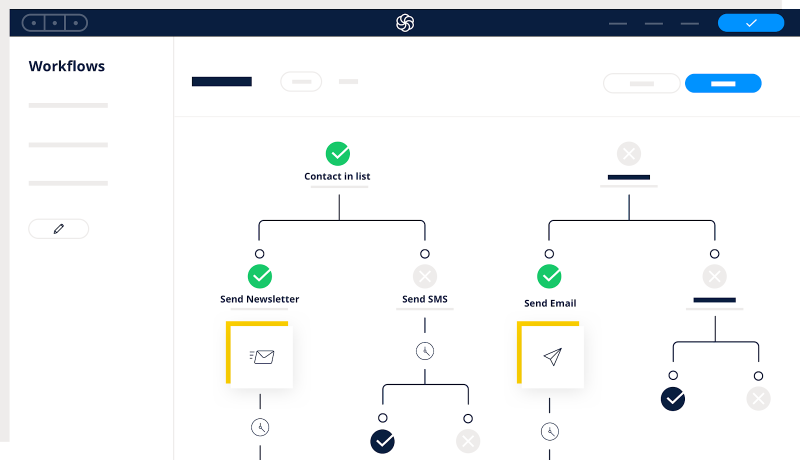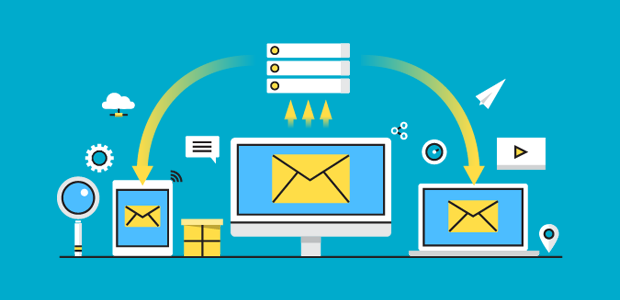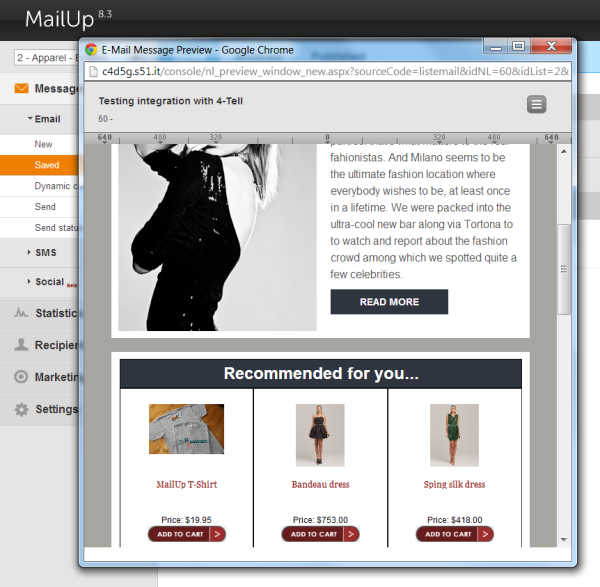Automation workflows are an essential subject for those who do any kind of repetitive tasks in their daily work. Automation creates a process or set of tasks that can be repeatedly executed with minimal to no human interaction; it's an invaluable tool for making our lives easier and our jobs more efficient.
Automation workflows go hand in hand with having the right business processes as these allow you to automate tasks and dictate the order in which those tasks will be executed. For example, a business process may dictate that automation will kick in once someone has taken a particular action and is ready to move to the next step.
In this article, we'll speak specifically about email automation workflows and how they play an integral role in the success of your email campaigns. By understanding the right types of automation that you can use, you’ll be able to successfully handle more leads, close more sales and achieve your business goals.
What Is An Email Automation Workflow?
An email automation workflow (aka an email campaign workflow) is a predefined set of tasks executed to send an email campaign successfully. There are many moving parts involved with automating campaigns; your workflows need to consider all aspects of the email life cycle, including:
For example, a new contact joins your mailing list. As soon as that happens, you would need a process in place that automatically adds those contacts to your master mailing lists. This list expansion task would happen long before your list was mailed to
A lot goes into creating and executing email automation workflows, which is why there are so many great email software solutions available on the market to help your business automate these processes.
Image Credit: http://sendinblue.com
If you were to create automated workflows from scratch, you’d have to invest a lot of time and resources into getting this done. However, these processes are typically taken care of by your chosen email service provider.
Top Benefits Of Using Email Workflow Automation Software
Let's take a look at how your business can benefit from having an automated email workflow solution in place.
Save Time And Resources
Automated workflows remove the need for manual list scrubbing, sender verification, and list expansion tasks (all essential tasks before sending). Automation software takes care of all of these processes behind the scenes, saving you and your team countless hours throughout the year.
Less Human Error
With zero chance of user error when using workflow automation tools, you won't have to worry about missing a step or having a task executed at the wrong time. This also safeguards your company’s reputation by sending the right emails at the right time.
Save Money
With all of the tasks being automated, you'll save money that would've otherwise been spent on labor and less efficient tools.
This money can be invested in other areas of your business that can help it to keep on scaling by putting the right resources (people or tools) in place.
Improve Deliverability
Sending on a more conducive schedule that adapts to your recipients' preferences leads to higher open/click rates, lower spam complaint rates, and better performance overall. It can also reduce the effects of email behavior filters on deliverability.

Image Credit: http://optinmonster.com
Workflow automation statistics also help with improved deliverability because they help your team understand which campaigns are driving the highest volume of opens and clicks. With this information in hand, you can create future campaigns with specific content to meet those needs.
Increase Volume
One of the most significant benefits of an email workflow automation solution is that it allows us to communicate more quickly and efficiently with the right people. Once a bulk mailing job has been assigned to an automation platform, it can process thousands or tens of thousands of emails in minutes (rather than hours or days). This means we can send larger mailings more frequently and not worry about needing to wait a long time to see visible results.
Having an automated campaign workflow tool at your disposal also allows you to send follow-up emails much more quickly; many workflows include tasks like sending second reminder emails at a set-time after an initial campaign is sent out.
More Targeted Campaigns
In addition to sending higher volumes of emails, you can create pre defined business rules that allow you to create more targeted campaigns. Automation software will allow you to upload your existing customer lists and merge them with other data sources such as email activity, website activity, and CRM records. All of this ensures that the majority of your audience receives relevant content tailored to their interests and needs – not just another one-size-fits-all bulk mailing like we've all seen many times before.

Image Credit: http://webengage.com
You may even want to create workflows that deliver personalized emails based on specific recipients' actions (or lack thereof). For example, if you notice someone constantly reads campaign A but never opens campaign B, your software can serve them campaign A again, followed by campaign B to increase engagement rates.
This level of email personalization increases overall open and click rates and helps improve the deliverability rate for future messages that are sent out, which is enhanced when emails are relevant and expected. This type of business process management even allows you to gather real-life data to constantly tweak and improve your processes.
10 examples Of Email Marketing Automation Workflows To Use In Your Business
Now that I've hopefully convinced you of the need for an email ‘robotic process automation’, let's have a look at workflow automation examples that you can set up as part of new or existing processes.
The following workflow examples will save you hours in manual tasks and are listed in no particular order. Keep in mind that they can even be mixed and matched together as needed.
1. Automation Welcoming New Users
Marketers can start the process of automating workflows by ensuring that new subscribers receive a welcome email after they've joined your newsletter list. You can automate this workflow using something as simple as double opt-in to ensure that only subscribers who want to receive emails from you will actually do so.
2. Automation For Product Launch Follow-Ups
If you have an eCommerce shop, then product launch follow-up workflows are essential in helping you keep track of campaigns over time. When someone has visited your website, ended up on your checkout page but didn't make a purchase, your workflow process can automatically send them a cart abandonment email. This email will remind them of the items they could buy and why getting that product would help solve a problem they have or give them another solution that hasn't yet been possible.
This workflow example should be used in conjunction with your product feed to ensure that after a user has visited specific product pages on your site, they receive tailored content and offers for products related to their initial interest.
3. Automation For Re-Engagement Campaigns
You can use re-engagement workflow tools to automatically send an email reminding users of an upcoming expiration date of an incentive or promotion you’re running. You could even send out multiple emails offering higher value incentives if recipients don't take the initial one within a specific timeframe.
This workflow example reminds existing customers about benefits they already know about but may have forgotten about over time; it also allows you to entice new customers by offering even more superb deals to encourage initial purchases.
4. Automation For Regular Newsletters
Of course, it's not just during the launch of a product or service that you'll want to send out email newsletters; you should also do so regularly as part of your marketing strategy. That's where automated workflow tools can help save time and effort with monthly, quarterly, or yearly email campaigns that are sent out automatically based on scheduling settings implemented in your newsletter software.
Set business rules that define when a newsletter is sent out and who it's being sent to - all via the right workflow automation processes.
5. Automation For Email Marketing Quality Score Improvement
If you use automation software, the logic needs to be smart enough to analyze current email KPIs and email metrics (such as click-through rates of existing campaigns) to determine which ones could do better with additional optimizations. By implementing business rules that recognize when a particular campaign isn't performing well or has been paused because it's not considered beneficial anymore, your email automation process can iterate on failed campaigns that didn't meet their performance goals.
This workflow example saves time and resources by ensuring that campaigns that don't meet their performance goals are automatically improved or updated as needed without manual intervention from marketers.
6. Automation For Celebrating The Birthday/Anniversaries Of Your Email Subscribers
Workflow software can also be used to track when users have been automatically added to your email list, then send them messages that congratulate them on making it this far. This is a great way to keep subscribers engaged and provide incentives for doing business with you; offering discounts or future exclusive offers can be a couple of methods to make use of.

Image Credit: http://blog.mailup.com
This workflow example integrates well with existing customer data to generate personalized messages based on the user's preferences as indicated through their purchase history or specific activity on your website.
You can also send us a best wishes email on someone's birthday, which is a nice gesture, primarily if your business is focused on eCommerce.
8. Automation For Real-Time Product Recommendations
Real-time product recommendations are a great way to offer personalized shopping experiences based on browsing activities and preferences of existing or prospective customers. The aim with this email workflow is simply to improve your conversions. This workflow example sends out relevant offers in real-time based on a number of factors that can easily be tracked on your website.

Image Credit: http://blog.mailup.com
9. Automation For Getting Feedback About Your Products/Services
Another way marketing automation can be applied is to send prospects and existing customers feedback requests after purchase or engagement with your business. This is an effective way to gather opinions about your products/services so that you can make informed decisions regarding overall strategy, especially if you're involved in retail, B2B sales and eCommerce.
This workflow example efficiently gathers information from users who opted in for such communications. It allows you to find weak links in your marketing, sales or even the products themselves; all of which can be taken into consideration and fixed. You’ll also be involving your customers in helping make the products they’re using that much better.
10 . Automation When Creating A Membership Site
Another application of marketing automation is in creating a membership site, which gives you the ability to reward your most loyal customers. Such members are given special benefits that encourage them to remain active on an ongoing basis.
New benefits can be offered over time based on engagement with specific content or features of the membership site. This is a great way to build up an audience for your business that knows, likes and trusts you.
What's The Best Type Of Automation For Your Email Marketing Business?
Understanding the processes (both manual and automated) that you currently have in place will help you identify the areas where further automation can potentially improve your business. In other words, start by understanding how you currently work and also look at the core functions of your business from a strategic perspective.
Here are some key questions to ask yourself that can help you take your email marketing campaigns to the next level through automation:
The answers to these questions will help you determine exactly what type of marketing automation is best for your email campaigns. Based on the nature of your business, there may be more than one area where you can introduce such technology.
For example, it's possible to invest in lead nurturing tools as well as workflow automation for sequencing emails over time. In addition, it might be beneficial to set up re-engagement reminders through automation based on specific behaviors or patterns that take place over weeks or months.
Measuring The Success Of Your Email Automation Workflows
The success of your automated processes is measured by the extent to which they are delivering results. These results can be calculated in terms of increased conversions, engagement, revenue and overall ROI.
The main goal here is to establish an effective system that can provide accurate feedback and precise data on how well different workflows are performing.
A few things to consider when measuring the effectiveness of your email automated processes include:Conclusion
Email automation workflows can be extremely useful in terms of increasing the success rate and ROI for your online business. For this reason, it's important to establish a system in which you can track and measure results in an accurate and efficient way.
While there are several factors to consider when measuring outcomes, lead generation, lead nurturing, revenue, and engagement stand out as the most common ones to consider when setting up email automation workflows.
By establishing clear goals and understanding how well different automated processes are performing, you will be able to make faster decisions regarding needed future changes. This means that you won’t have to rely on assumptions or intuition when it comes to what really matters in your business.



0 comments